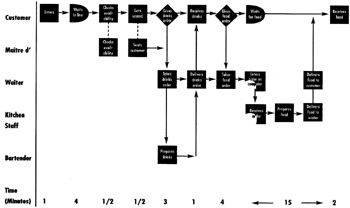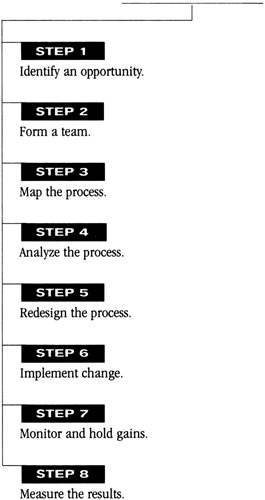Re-engineering Work Processes
You're in the business of satisfying your customers. Studies show that one of the primary reasons for losing customers is slow service. Doing things right and doing them fast are really important. Yet studies of most work processes will indicate that they are hopelessly inefficient. In fact, the processes usually add value only 5 percent of the time. In other words, 95 percent of the time the process is at a standstill.
By mapping out work processes, you have a magnificent opportunity to identify waste and duplication. Changes — when significant in size and scope — will enthrall your client and reduce frustration on the part of the people providing the service.
-
Identify a process that can be improved significantly. Pick a process that
-
is causing customer frustration and complaints;
-
could save significant dollars if improved;
-
relates to the departmental and corporate mission;
-
is relatively simple to solve;
-
can yield a measurable improvement.
-
-
-
Form a team. Invite six to ten people to help you improve the process. The team should represent all stages of the process and include people from two or more departments. Select people who
-
understand the process;
-
are concerned about improvement;
-
will make the time to work on the team;
-
have the power to make changes.
-
-
If your team consists of front-line people, you will need a mandate from a senior manager to make changes. Such a mandate will give participants the feeling that their hard work will not be in vain.
-
Hold your first team meeting. At the kick-off you should
-
introduce members to one another;
-
explain the process and the steps you will be taking;
-
train people in the tools of process-mapping;
-
get commitments from all members regarding their participation.
-
-
-
Map the process. Give people a week to collect information from the perspective of their work areas. Invite them to a meeting at which you will map the process.
-
At the next meeting, record all the steps of the process on a white board. The board should be pre-drawn with the names of the people who are involved on the left and the time on the bottom (see page 263).
Example of a Process Map
-
Note the opinions of participants as you guide them through the steps of the process. Record activities, starting on the left side and moving to the right. Write each activity or decision on a Post-It Note. The advantage of a Post-It is that it can be moved easily. If you are unsure about any part of the map, leave it blank and continue. You can do detailed research later.
-
Use appropriate symbols for each step in the process. The most commonly used icons are:
Process Mapping Symbols

-
The process map should show
-
each step;
-
the inputs and outputs of each step;
-
all decisions;
-
the people involved;
-
the time needed to do each step.
-
-
Create a draft drawing of the process and allow team members an opportunity to confirm its accuracy with their peers.
-
-
Analyze the process.
-
At your next meeting, adjust the process based on feedback from team members.
-
Ask the team:
-
Is each step necessary?
-
Is the flow logical?
-
Does each step add value?
-
Are some activities missing?
-
Are some steps wasteful?
-
Is there duplication?
-
-
List the problems. Prioritize them based on their impact on the customer, their cost, and their time requirements.
-
Deal with the major problems primarily by developing action plans to improve them.
-
If the process is inefficient, consider scrapping it and starting anew. You can establish new ways of improving the process by considering one or a combination of different options:
-
Outsourcing. Research whether some other organization can do all or some aspect of the process better, cheaper, or faster than can be done internally.
-
Finding new technological solutions. Are there new equipment, software, or Internet solutions that can be applied to improve the process?
-
Benchmarking. Find other organizations who have similar processes that they do better and faster than you do. Find out how much better they do the process and how they achieve this.
-
-
-
Redesign the process. Based on the team's ideas, redraw the process map to reduce waste, duplication, and time.
-
Implement change.
-
Develop action plans for all the improvements.
-
Spread the changes among as many people as possible to ensure that the workload is evenly distributed.
-
Hold meetings with all those affected to make sure that they
-
understand the changes;
-
agree to the changes;
-
will make the changes.
-
-
-
Monitor and hold gains.
-
Follow up with people to make sure that the changes are being implemented.
-
Encourage and recognize efforts to reduce the difficulties usually associated with change.
-
-
Measure the results. Keep a tally of the improvements. Charting them and displaying them for everyone to see will promote pride in all those responsible. It will also increase enthusiasm for your next process-improvement project.
PROCESS IMPROVEMENT ROAD MAP

EAN: N/A
Pages: 109